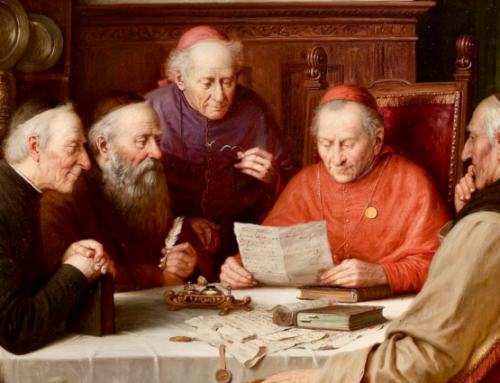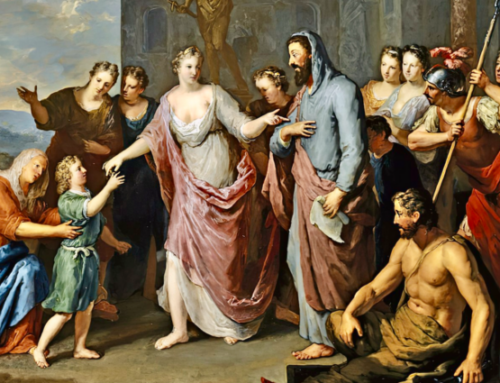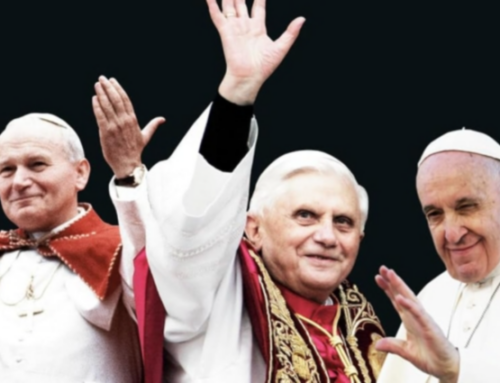Hector Berlioz’s version of the “Te Deum” surpasses them all in its colossal scale. The French composer has often been accused of bombast, but here the gigantic forces required are completely fitting for this cosmic hymn of praise.
“[I]t was enthusiasm itself that inspired the Te Deum…[A]mid clouds
of smoke and yet reeking blood, a French army, scathed with
the thunderbolts of war, bowed the knee to the flourishes of
clarions and trumpets, and joined in a hymn of praise to the
God of battles.”
—François-René de Chateaubriand, The Genius of Christianity
An often overlooked aspect of Romanticism is its revival of the religious spirit. One can chide Romantic works of art for their emotionalism, yet the emphasis on the fantastic and imaginative in Romantic literature, music, and painting was in large part a protest against the dry rationalism of the Enlightenment. If 18th-century philosophes scoffed (sometimes quite ignorantly) at revealed religion, artists of the Romantic age would show a new appreciation for Christianity, religious art, and the Ages of Faith that produced it.
Much of this rebirth of the religious imagination can be traced to a single book, Le Génie du Christianisme by Francois René de Chateaubriand, France’s leading Romantic thinker. Chateaubriand (1768-1848) came by his Christian convictions in the crucible of the French Revolution, in which he took the royalist side and saw a number of his friends and family members killed. He fled to England and also spent time in the United States among the Indians of New York, an experience that would influence his thought on religions and cultures. The death of Chateaubriand’s mother in 1798 prompted him to reconvert to the Catholic faith of his childhood and in 1802 to write Genius—a word which Chateaubriand uses to mean “distinctive character or spirit.”
Although Chateaubriand addresses Christian doctrine in the earliest chapters, the heart of the book, and its signal contribution, is a defense of Christianity centering on art and beauty. Chateaubriand aims to prove that “Christianity comes from God, because it is excellent” and to show forth the full extent of that excellence in arts, letters and morals. The central portions of Genius deal with “The Poetry of Christianity,” “Fine Arts and Literature” and “Worship” (taking in all the physical and auditory elements of liturgy). Chateaubriand rehabilitated Christianity for his era by proposing fresh objects for contemplation from the storehouse of Christian culture, showing Enlightenment thinkers to have been culturally blinkered in many respects. He was one of the first to recognize the value in Gothic architecture and Gregorian chant, and his book led to the Romantic revival of these artistic styles—a revival that is still part of our lives today.
For Chateaubriand, the Christian way of life itself is beautiful, and he examines such topics as country churchyards, priestly vestments, and Corpus Christi processions amid the burst of Spring in a way that blends a Christian conscience with a Romantic awareness of nature; one of his chapters bears the ultra-Romantic title “Harmonies of the Christian Religion with Scenes of Nature and the Passions of the Human Heart.”
A recurrent theme of the book is the essential unity of Christian and classical culture in making up Western civilization. “People are incessantly extolling the institutions of antiquity,” the author laments, “and they will not perceive that the Christian worship is the only relic of that antiquity which has been transmitted to us.” Chateaubriand constantly stresses that Christianity gathered up and assimilated what was best in the classical world and added a supernatural element that the classical world could not have imagined. In doing so, Chateaubriand places ancient Jewish culture on a par with the Greco-Roman; one of the chapters on literature includes an extensive comparison of Homer and the Bible, judging the latter much superior.
Chateaubriand’s Genius reawakened the Christian sensibilities of France and beyond, and it still works its charms today. Even a casual perusal of its 600-plus pages will yield choice bits and poetically fragrant passages (“The Christian religion… is essentially melodious, for this single reason, that she delights in solitude”). The book is encyclopedic, leaving no stone unturned in its quest to show that Christianity is compatible with nature, reason, and the best in human accomplishment. (Chateaubriand ridicules the ten-day week promulgated by the Revolution as being against all three.) In his use of beauty, poetry, and the imagination, Chateaubriand opened an apologetic door that such later writers as Chesterton would enter.
Chateaubriand emerges from Genius as an original proponent of imaginative conservatism. He recognized that science and philosophy do not make civilization of themselves, but depend on the works of the imagination for sustenance—and that these in turn depend on what Christianity provides, a faith in something beyond reason.
“Painting, architecture, poetry, and the higher species of eloquence, have invariably degenerated in philosophic ages; because a reasoning spirit, by destroying the imagination, undermines the foundation of the fine arts. We fancy ourselves more enlightened because we correct a few errors in natural philosophy, substituting, however, all the errors of reason in their stead; and we are, in fact, going backward, since we are losing one of the finest faculties of the mind.” (388)
** *
One person who found great value in The Genius of Christianity was Napoleon Bonaparte, then on a campaign to reverse the anti-religious animus of the French Revolution and reinstate Catholicism in France. Practice of the faith had been driven underground, and the rationalist cult of the Revolution had failed to take hold. Bonaparte recognized the dangers a divided church would pose to national unity. With the help of Chateaubriand’s book, the faith of the catacombs began to rise to the surface in an outright Catholic revival. To see a musical reflection of the change, we might turn to the choral works of Hector Berlioz.
As the first complete Romantic in music, Berlioz (1803-1869) stands comparison with Chateaubriand in literature. Both men were raised by devout Catholic mothers but later abandoned the faith. Unlike Chateaubriand, Berlioz did not recover it. Yet despite not possessing an active faith, Berlioz was friendly to Christian culture and sensibilities and, on his own initiative, created a group of religious works that are among his masterpieces. These include his Requiem Grande messe des morts (1837), his nativity oratorio L’enfance du Christ (1854), and the magnificent Te Deum. This latter work was originally dedicated to Louis Napoleon but later switched to Albert, Prince Consort to Queen Victoria.
Berlioz took as his text the splendid 4th-century Latin hymn recited daily in the Holy Office and sung on various solemnities of the church.
Te Deum laudamus: Te Dominum confitemur.
Te aeternum Patrem omnis terra veneratur.
Tibi omnes Angeli; tibi Caeli et universae Potestates;
Tibi Cherubim et Seraphim
incessabili voce proclamant:
Sanctus, Sanctus, Sanctus,
Dominus Deus Sabaoth.
Pleni sunt caeli et terra
maiestatis gloriae tuae.O God, we praise Thee: we acknowledge Thee to be the Lord.
Everlasting Father, all the earth doth worship Thee.
To Thee all the Angels, the Heavens and all the Powers,
all the Cherubim and Seraphim,
unceasingly proclaim:
Holy, Holy, Holy, Lord God of Hosts!
Heaven and earth are full of the Majesty of Thy glory.
The poem goes on to include the apostles, prophets, saints and “white-robed army of martyrs” among the throng praising God. It addresses Christ as “King of glory” and evokes the bitter price of the Passion (mortis aculeo/the sting of death) as prelude to the kingdom of heaven. What the Te Deum presents is nothing less than an image of the Beatific Vision, and it has inspired a roll call of great composers through the ages.
Besides the traditional chant, these have included Handel, Haydn, Mozart, Verdi, and Bruckner, but Berlioz’s version surpasses them all in its colossal scale. The French composer has often been accused of bombast, but here the gigantic forces required—two adult choirs and a children’s choir, a large orchestra including no fewer than twelve harps, tenor solo, and an organ placed in a different section of the hall—are completely fitting for this cosmic hymn of praise.
The music had a long gestation, with some of it dating as far back as the 1824 Messe Solennelle (an early Berlioz work that was thought lost until the 1990s). Although Berlioz put the finishing touches on the Te Deum in 1849, it was not premiered until April of 1855. The composer led an ensemble of some 900 performers (most modern performances are considerably scaled down) at the Church of Saint-Eustache in Paris. That same night Berlioz wrote excitedly to his friend, composer Franz Liszt: “It was colossal…. I assure you that it is a tremendous work, the final movement surpasses all the enormities of which I am guilty up to now.”
That final movement is the Judex crederis, evoking Christ as final judge. The doom-laden rhythmic motto of the opening words sets the tone, but the words In te, Domine speravi/Non confundar in aeternum (O Lord, in thee have I trusted; let me never be confounded) rise up as a powerful counter-force. Interestingly, Berlioz designates each movement of the Te Deum as either a hymn (Hymne) or prayer (Prière), but this last movement is designated as both—a song of praise that is also a supplication to withstand divine judgment. The ending of the work seems to affirm, in a blaze of B-flat major, the final triumph of the soul.
But this finale represents only one side of the Te Deum. At times Berlioz gives us intricate counterpoint in the spirit of Bach, the music teeming with exuberant, swirling detail. This is balanced against moments of profound rest and contemplation, like the Dignare for chorus and the two solo tenor prayers. These latter movements have great tenderness and lyricism, with a plum role for a sensitive operatic tenor. Berlioz marshals his forces carefully, saving the full ensemble for the grandest moments.
On some level, Berlioz’s Te Deum is a descendant of the open-air patriotic choral festivals staged during the French Revolution, in which hundreds of performers offered hosannas to the regime under titles like Triumph of the Republic and Hymn to Reason. (The composers of those paeans, such as Gossec and Méhul, are more or less historical footnotes now.) But the Te Deum transcends this background, reconnecting us with the great sacred tradition of Palestrina, Bach, and Beethoven’s Missa Solemnis, which opened up the genre of religious concert music. Instead of liturgical worship, such sacred works are intended for contemplation in the symphony hall or at a church concert. Ever the Romantic individualist, Berlioz shuffles the words of the text around a bit, but never to distortion. The Te Deum shares more of the humility and radiance of L’Enfance du Christ than the self-dramatizing flair of the Symphonie fantastique, Berlioz’s great autobiographical symphony.
Musicologist Donald J. Grout describes Berlioz’s religious output as a “collision of Romantic musical energy with sacred themes.” You can hear this clearly in the original finale of the Te Deum, a “March for the Presentation of the Colors” that is often omitted in modern performances—a pity, because even without the flag ceremony that must have accompanied it, the march makes for a delightful epilogue to the work. Here, for a brief shining moment, the secular and sacred are reconciled, and the self-confident swagger of the French Revolution seems to be rededicated to God.
Editor’s Note: This is part of a series of essays commemorating the 150th anniversary of the death of Hector Berlioz.
The Imaginative Conservative applies the principle of appreciation to the discussion of culture and politics—we approach dialogue with magnanimity rather than with mere civility. Will you help us remain a refreshing oasis in the increasingly contentious arena of modern discourse? Please consider donating now.
The featured image is a photograph of a stained glass window in the Sorrowful Mother Shrine Chapel (Bellevue, Ohio), courtesy of Wikipedia; the portrait of the Young Chateaubriand, by Anne-Louis Girodet (c. 1790), and the image of Hector Berlioz (1845) by Kriehuber are courtesy of Wikipedia.










Very much enjoyed this. I’m reading Chateaubriand’s memoirs and this essay has whetted my appetite for his book on Christianity.